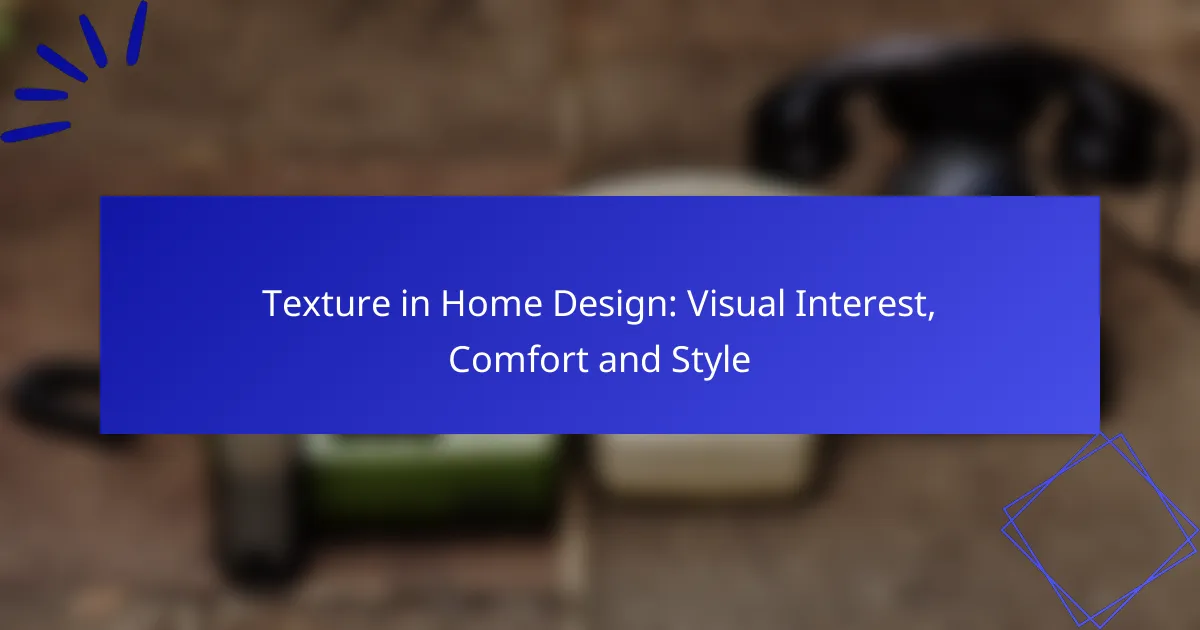Texture plays a crucial role in home design by adding depth, character, and a sense of comfort to living spaces. By thoughtfully incorporating a variety of materials and finishes, homeowners can create inviting atmospheres that reflect their personal style while enhancing visual interest. From natural fibers to wood and metal accents, the right textures can transform a space, making it both stylish and cozy.

How does texture enhance home design in urban settings?
Texture enhances home design in urban settings by adding depth and character, making spaces feel more inviting and personalized. By incorporating various materials and finishes, urban dwellers can create a unique atmosphere that reflects their style while addressing the challenges of limited space.
Visual interest through varied materials
Using a mix of materials like wood, metal, glass, and stone can create striking visual interest in urban homes. For instance, pairing a sleek metal table with a rustic wooden bench introduces contrast that draws the eye. Consider incorporating textured wall finishes, such as exposed brick or stucco, to add dimension to otherwise flat surfaces.
When selecting materials, aim for a balance that complements your overall design theme. A good rule of thumb is to choose three to five different textures to avoid overwhelming the space while still maintaining visual appeal.
Comfort with soft furnishings
Soft furnishings, such as cushions, rugs, and throws, play a crucial role in enhancing comfort in urban homes. Opt for fabrics like cotton, linen, or velvet to create a cozy atmosphere that invites relaxation. Layering these soft elements can also help define areas within open-plan spaces, providing both comfort and functionality.
When choosing soft furnishings, consider the durability of materials, especially in high-traffic areas. Fabrics that are easy to clean and maintain will ensure your space remains inviting without excessive upkeep.
Style with layered textures
Layering textures is an effective way to add style and sophistication to urban interiors. Combine different fabric types, such as a plush velvet sofa with a woven wool throw, to create a rich, inviting look. This technique not only enhances aesthetic appeal but also adds warmth to the often stark urban environment.
To successfully layer textures, start with a neutral base and gradually introduce contrasting elements. Aim for a cohesive color palette to tie the different textures together, ensuring that the overall design feels harmonious and intentional.

What are the best textured materials for home interiors?
The best textured materials for home interiors include natural fibers, wood finishes, and metal accents. These materials enhance visual interest, provide comfort, and contribute to the overall style of a space.
Natural fibers like cotton and linen
Natural fibers such as cotton and linen are excellent choices for adding texture to home interiors. They are soft, breathable, and available in various weaves and patterns, making them versatile for upholstery, curtains, and bedding.
When selecting natural fibers, consider their durability and maintenance. Cotton is generally easy to clean and maintain, while linen may require more care to prevent wrinkles. Both materials can be found in a range of colors, allowing for creative combinations.
Wood finishes for warmth
Wood finishes are ideal for introducing warmth and a sense of nature into your home. Options like oak, walnut, and maple can be used in flooring, furniture, and cabinetry, providing a rich texture that complements various design styles.
When choosing wood finishes, consider the grain patterns and stains that can enhance the texture. Lighter woods tend to create a more airy feel, while darker woods add depth and sophistication. Ensure proper sealing and maintenance to preserve the wood’s appearance over time.
Metal accents for modernity
Metal accents bring a contemporary touch to home interiors, adding sleekness and contrast to softer materials. Common metals used include stainless steel, brass, and copper, which can be incorporated through fixtures, furniture, and decorative elements.
When using metal accents, balance is key. Pairing metals with natural materials can create a harmonious look. Be mindful of finishes; for example, brushed metals offer a more subdued appearance, while polished finishes can add shine and drama to a space.

How can texture improve comfort in living spaces?
Texture enhances comfort in living spaces by adding tactile elements that create a more inviting atmosphere. Incorporating various materials can influence the overall feel of a room, making it cozier and more enjoyable to inhabit.
Soft textiles for seating
Using soft textiles for seating, such as plush fabrics or cushions, significantly increases comfort. Consider materials like velvet, microfiber, or cotton blends, which not only feel good against the skin but also add visual warmth to the space.
When selecting textiles, aim for a mix of textures to create depth. For example, pairing a soft sofa with knitted throws or patterned pillows can enhance both comfort and style.
Rug selections for warmth
Rugs play a crucial role in adding warmth and comfort to living areas. Opt for thick, plush rugs made from wool or synthetic fibers that provide a soft underfoot experience, especially in colder climates.
When choosing a rug, ensure it complements the seating arrangement and fits the scale of the room. A larger rug can unify the space, while smaller rugs can define specific areas, such as a reading nook.
Wall textures for sound absorption
Incorporating textured wall materials can improve sound absorption, creating a quieter and more comfortable environment. Options like fabric wall panels, acoustic tiles, or textured wallpaper can help reduce echo and noise levels.
When selecting wall textures, consider both aesthetics and functionality. Soft materials can enhance comfort while also serving as a design element, contributing to the overall ambiance of the room.

What role does texture play in color schemes?
Texture significantly enhances color schemes by adding depth and visual interest. It can influence how colors are perceived, creating a dynamic interplay that can either harmonize or contrast with the overall design.
Contrast through different finishes
Using contrasting finishes can create striking visual effects in a space. For instance, pairing a matte wall with glossy furniture can draw attention and highlight specific areas. Consider using a mix of materials like wood, metal, and fabric to achieve this contrast effectively.
When selecting finishes, think about the balance between bold and subtle textures. Too much contrast can overwhelm a room, so aim for a harmonious blend that still allows for visual excitement.
Complementary textures for cohesion
Complementary textures work together to create a cohesive look in home design. For example, soft textiles like velvet can pair beautifully with hard surfaces like glass or stone, providing a sense of balance. This combination can make a space feel more inviting and comfortable.
To achieve cohesion, consider the overall theme of your design. Stick to a limited palette of textures that reflect your style, whether it’s rustic, modern, or eclectic. This approach helps maintain a unified aesthetic while still allowing for variety.

How to choose textures for specific rooms?
Choosing textures for specific rooms involves considering the room’s function, desired atmosphere, and the overall design theme. Different textures can enhance comfort, visual interest, and style, making it crucial to select materials that align with each space’s purpose.
Living room: Cozy and inviting
For the living room, opt for textures that create a warm and welcoming environment. Soft fabrics like velvet or chenille for sofas and cushions can add comfort, while natural materials such as wood or stone can bring an organic feel.
Layering textures is key; consider combining a plush area rug with smooth leather furniture or woven baskets for storage. This mix not only enhances visual interest but also encourages a cozy atmosphere for relaxation and socializing.
Bedroom: Soft and serene
In the bedroom, aim for textures that promote tranquility and comfort. Soft linens, such as cotton or bamboo, for bedding can create a serene sleeping environment. Incorporating plush throw blankets and pillows can add layers of softness.
Consider using calming colors and gentle textures on the walls, like a matte finish or wallpaper with a subtle pattern. This combination fosters a peaceful retreat, essential for restful sleep.
Kitchen: Durable and functional
The kitchen requires textures that are both durable and easy to maintain. Materials like stainless steel for appliances and quartz or granite for countertops provide a sleek, functional surface that withstands daily use.
Incorporate textures that enhance practicality, such as tile backsplashes that are easy to clean and resilient flooring options like vinyl or ceramic. These choices ensure the kitchen remains stylish while being equipped for the demands of cooking and entertaining.

What are the emerging trends in textured home design?
Emerging trends in textured home design focus on integrating a variety of materials to create visual interest and enhance comfort. Homeowners are increasingly experimenting with textures like natural fibers, metals, and ceramics to achieve unique aesthetics and tactile experiences.
Natural Materials
Natural materials such as wood, stone, and clay are gaining popularity in home design due to their organic appeal and sustainability. These elements not only add warmth but also provide a sense of connection to nature, which many homeowners seek in their living spaces.
Consider incorporating reclaimed wood for flooring or accent walls, which can introduce character and history into a room. Stone countertops and clay pottery can also enhance the tactile experience while promoting an eco-friendly approach.
Layering Textures
Layering different textures is a key trend that adds depth and complexity to interior spaces. By combining materials like soft textiles with hard surfaces, designers can create a balanced and inviting atmosphere.
For example, pairing a plush velvet sofa with a sleek metal coffee table can create a striking contrast. Use throw pillows, rugs, and curtains to introduce additional textures that complement the overall design theme.
Bold Patterns and Textures
Bold patterns and textures are becoming more prevalent as homeowners look to express their individuality. This trend encourages the use of statement pieces that draw attention and serve as focal points within a room.
Incorporating patterned wallpaper or textured tiles can instantly elevate a space. Opt for geometric designs or vibrant colors to make a statement, but balance them with neutral furnishings to avoid overwhelming the area.
Textured Finishes
Textured finishes on walls and furniture are increasingly popular for adding visual interest without the need for additional decor. Techniques like stucco, plaster, or textured paint can transform a plain surface into a dynamic feature.
When selecting textured finishes, consider the overall style of your home. For a rustic look, rough-hewn finishes work well, while smoother textures may suit a modern aesthetic. Always test samples to ensure the desired effect aligns with your vision.





